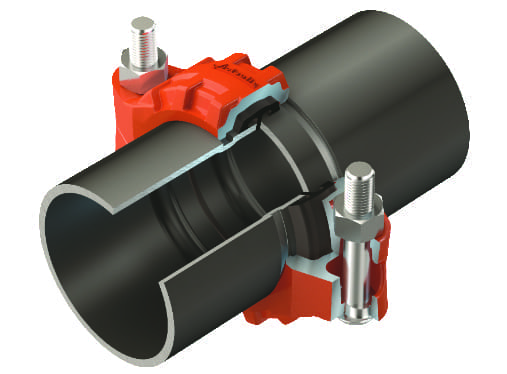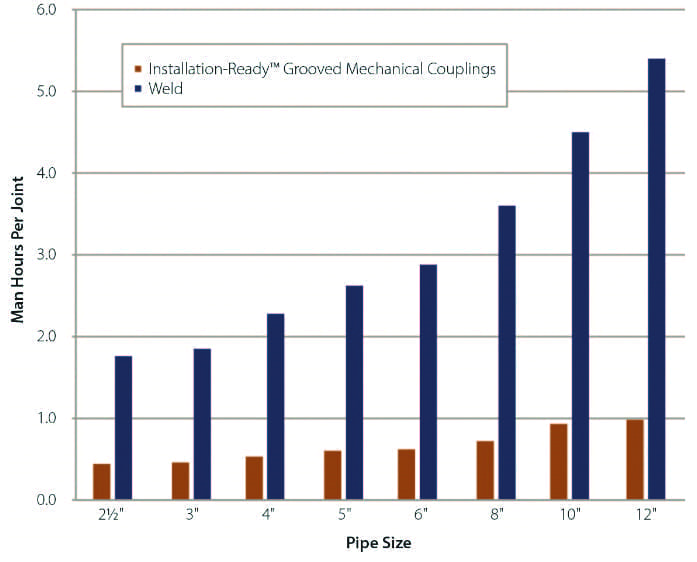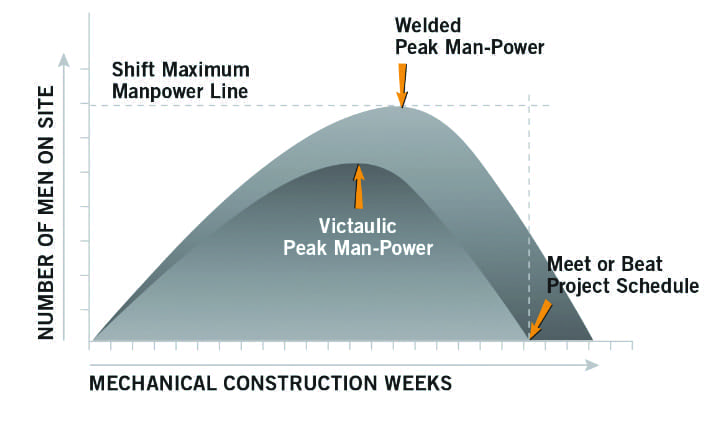Unlocking Big Value for Utility Piping Systems
Up to 40% of a power plant’s piping is above-ground utility piping. Choosing the right joining method can help maximize efficiencies and have an outsized impact on overall project economics.
The power generation sector in the U.S. is evolving rapidly, and companies building and managing power plants are changing as well. The number of gas-powered plants is increasing, and in a growing percentage of the country’s power plants, renewables such as wind, solar, and hydro are being coupled with natural gas as a fuel source.
Today’s low feedstock costs have created a landscape in which multiple fuel sources now are on a relatively equal footing, and renewables are gaining ground. The obvious consequence of this transition to gas and renewables is that there are far fewer coal-powered plants in the U.S. than there used to be. Coal, which powered approximately 75% of facilities several years ago, is used in less than 35% of power plants today.
The construction side of power generation also has experienced changes, and these changes have influenced the way new generation and retrofits are being executed. Ten years ago, engineer, procure, and construct (EPC) contracts were just making an appearance in the power generation industry. Today, EPC contracts are very common, and more companies are offering fixed-price EPC project delivery in a much more competitive environment.
Finding ways to reduce jobsite labor hours and deliver construction efficiencies have become part of this new normal. EPC companies are creating turnkey designs they can “cut and paste” in future jobs to deliver expedient solutions. Successful implementation of these initiatives has resulted in dramatically shorter project schedules, which has permanently altered expectations on the part of asset owners. Today, it is possible to complete a gas-fired power plant in two and a half years that only a few years ago would have taken five years to build. That means a plant can be producing power—and generating revenue—in half the time.
From the owner’s perspective, the decision to award a project very often is based on which company can build the facility fastest with the best quality to enable a quick transition to production and revenue generation. For construction companies, this ups the ante and hands a competitive advantage to those that can meet a tight schedule.
While many things have changed in the power generation industry, some very important things have remained the same. There is a continuing expectation for construction companies to deliver safety, efficiency, reliability, and quality. Irrespective of the project challenges, owners want construction companies to produce results on budget and on time without compromising any of these critical requirements.
Expanding Power Generation
Power plant owners are making investment decisions for new builds and retrofits, and many are leaning toward natural gas-fueled facilities. According to the U.S. Energy Information Administration, which collects a range of data on the electric power industry in the U.S., the average construction cost for a natural gas power plant was approximately $920/kW in 2017. This is slightly more costly than building a plant powered by petroleum liquids but much less expensive than building a plant fueled by renewables.
Above-ground pipe joining has been synonymous with welding; anyone who has ever been involved in a project that includes welding knows that welding poses challenges. Hot work permits must be secured before work can begin, and welding requires skilled workers, who are not always readily available, especially in today’s tight labor market. Also, because welding is weather dependent, inclement conditions can delay progress, and in dry and windy conditions, welding often requires a fire watch, which means additional workers are on-site and potentially in harm’s way.
Rather than sticking with what has been done most often, it could be advantageous to cast the net wider and consider using mechanically grooved couplings instead of welding. For utility piping utilized in systems such as service water, cooling water, air systems, glycol, and nitrogen, which can represent 30% to 40% of the piping component of the job, using grooved mechanical couplings (Figure 1) could lead to significant cost savings.
 |
|
1. Grooved mechanical joints can lead to significant cost savings and further efficiencies for above-ground utility piping. Courtesy: Victaulic |
Grooved mechanical couplings are very familiar to most EPC and construction companies. Many have used this technology for years on fire protection and heating, ventilation, and air conditioning (HVAC) systems. Contractors have gravitated to these couplings for speed and reliability, as well as improved safety. The couplings install without the use of hot work or burn permits, so installers are not exposed to fumes or flames and do not need to contend with tanks, torches, or lead lines during installation.
Time Is Money
Managing labor is part and parcel of every construction project, and everyone in the construction sector has had to deal with the shortage of skilled laborers. Finding the right people with the required skills has been difficult in North America, and the lack of workers has negatively impacted project schedules.
Today, the worker shortage in North America is greater than ever, and there is no solution to this problem on the horizon. The truth is that if a project experiences a labor shortage for critical activities, such as welding, the impacts on the project are far and wide.
Using mechanical grooved couplings is an innovative and cost-effective method. This technology offers advantages over welding in that it requires no hot work, no burn permits, no fire watch, and no X-ray, and the simple design of the coupling means installation can be carried out using standard hand tools.
On a recent project, more than 120 pipefitters were trained to install mechanically grooved couplings in less than 20 minutes. This team of pipefitters were able to execute the complete project rapidly and without incident. On average, even for beginners, installing a grooved mechanical system is 50% to 60% faster than welding (Figure 2).
 |
|
2. Installation time of grooved mechanical joints is faster and more efficient compared to welding. Courtesy: Victaulic |
Another advantage of using mechanical grooved couplings is that the system can be prefabricated, which not only delivers product consistency, but also saves time because spools arrive at the construction site ready to install. Prefabrication creates greater productivity savings and safety enhancements compared to field assembly.
Precise installation is vital for components in a power plant, which is one of the reasons it is so important to make sure the welders on the job are trained and qualified. It is not easy to discern the quality of a finished weld by looking at it, and even testing or X-ray does not always allow a weak joint to be identified. A poorly executed weld can be extremely costly, leading to failures over time that can result in serious physical and financial losses.
The visual inspectability of a mechanical grooved coupling simplifies quality control and enables installers with even basic skills to verify every joint is properly installed. This removes the additional quality control documentation required for weld inspection, including X-ray and/or dye penetrant testing.
Mechanical joints also are easier to maintain. Traditionally, repairs to welded joints are much more time-consuming and costlier. However, it’s as easy to change out mechanical grooved joints as it is to install them, and because nearly anyone working in the power plant could be trained in a matter of minutes to replace them, there are considerable cost savings that can be captured over time (Figure 3). Given that a typical 1,000-MW power plant generates $1 million/day in revenue, limiting the amount of time the plant is offline or not at full capacity can pay huge dividends.
 |
|
3. Workers are more efficient with Victaulic’s solution versus welding solutions. Courtesy: Victaulic |
Solutions in Action
Mechanical grooved couplings have been used for many years on a broad range of power plant applications at several high-profile power generation sites. This technology has been utilized for more than 100 years and has a proven track record.
During a tightly scheduled plant outage at a hydroelectric power plant in New Jersey, a mechanical grooved solution enabled a new cooling water and fire protection system to be installed within serious time constraints. In a plant in Pennsylvania, mechanical grooved couplings were used on compressed and instrument air lines to meet an accelerated construction schedule; also, a plant in Arkansas used the technology for the same reason on its instrument air, compressed air, de-ionized water, and cooling water lines. In a retrofit project in a power plant in Alaska where hot work was not permitted on the site and skilled labor was scarce, a grooved mechanical pipe joining system was used to upgrade the makeup system that supplies water for the steam turbine, providing a solution that not only met the requirement for no hot work but also delivered thousands of dollars in labor and schedule savings.
The construction sector, like many others, has been under pressure to create greater efficiencies and cost-saving methods. This has placed greater demands on owners, EPCs, and contractors. More than ever before, there is a need to evaluate and utilize innovative ways to successfully execute projects within or under budget.
Delivering reliable solutions becomes even more important when market conditions are constrained and turbulent. Although it might seem counterintuitive to follow a different path in these exacting circumstances, in fact, it is in times like these that a traditional solution could be the biggest impediment to capturing savings. There is no time better than the present to think outside the box to use the Victaulic mechanically grooved pipe joining system. ■
—Dan Christian is a chartered energy and petroleum engineer, and director of the Global Power Market at Victaulic, and Chris Iasielo, PE is a power generation specialist at Victaulic.